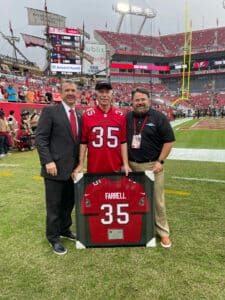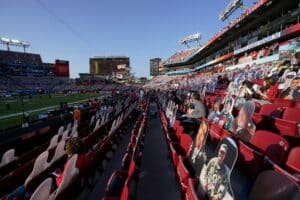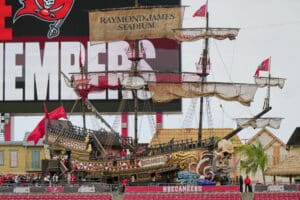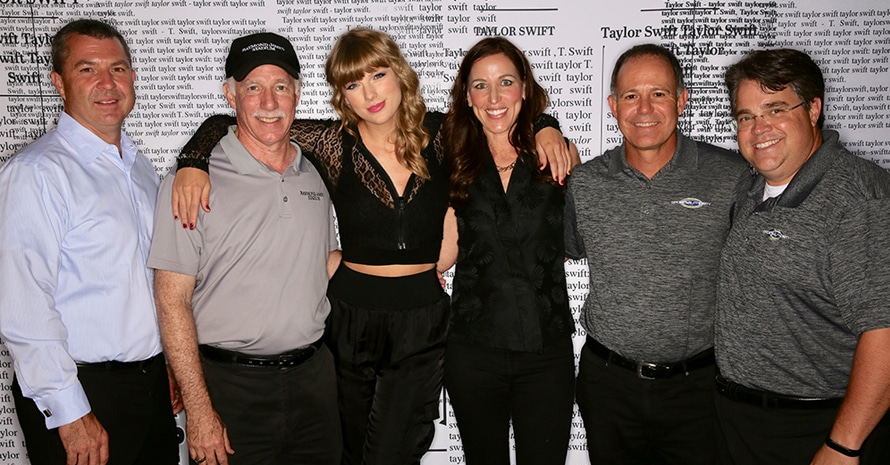TAYLOR IN TAMPA: Mickey Farrell welcomed Taylor Swift to Raymond James Stadium for her 2018 concert. From left, Brian Ford, Tampa Bay Buccaneers; Farrell, RJS senior vice president of operations; Swift; Darcie Glazer Kassewitz, Tampa Bay Buccaneers Foundation; and Tony Muniz and Eric Hart, Tampa Sports Authority. (Courtesy venue)
Farrell played host to four Super Bowls, from Gulf War to COVID
Mickey Farrell had no easy task on the night of May 17, 1992. British pop band Genesis, in the early stages of the “We Can’t Dance” tour, had just started their concert at old Tampa Stadium before lead singer Phil Collins lost his voice, forcing the show to be cut short two songs into the set.
Farrell, the stadium’s director of operations at the time, had the daunting responsibility to go on stage and inform the crowd of 41,000 that the rest of the concert was canceled. The event was not rescheduled and patrons ultimately got refunds after shelling out $25 and $35 for tickets.
“I was a young whippersnapper; I’d been stadium director for two years,” he recalled. “Fortunately, it was a calm crowd. The band went to the locker room and played ping-pong while waiting for their flight. At first, (promoter) Cellar Door couldn’t find a ping-pong table. I had one at home and we sent a truck to my house and brought it over. I regret not getting them to sign it.”
The short-lived concert is among the memories that stand out for Farrell over the course of his 35 years running Tampa Stadium and its successor, Raymond James Stadium. Farrell, 61, officially retired on July 31 from his post as the venue’s senior vice president of operations.

BUCKING ODDS: Mickey Farrell, flanked by Brian Ford, left, and Eric Hart, receives a framed Tampa Bay Bucs jersey as a retirement gift, tied to his 35 years on the job. (Courtesy venue)
All told, Farrell played host to four Super Bowls during his tenure in Tampa. His first and final ones were played under extenuating circumstances. Super Bowl XXV was played in 1991 during the Gulf War, resulting in increased security measures for the game and the first installation of a secured perimeter, a physical barrier that still remains a critical piece of crowd management for Super Bowl.
That same year, stadium officials snuck over to the University of Tampa the night before the Super Bowl to unearth a 900 square foot chunk of sod at the school’s soccer field to replace dead grass at midfield containing the game logo at Tampa Stadium. It had been worn out from halftime show rehearsals over the course of the week and George Toma, the NFL’s groundskeeper for Super Bowl, was desperate to find a solution, Farrell said.
All fingers pointed in the direction of the small private school in town where Farrell had been an academic all-American in baseball, earned his bachelor’s degree in business management and was employed with the facilities group on campus before he joined the Tampa Sports Authority in 1987 as assistant director of operations.
“I used to work there and still had the gate keys,” Farrell said. “Without the school knowing it, we dug up a portion of turf. It was thick sod, so it would stay in place. We brought it over and repainted the logo.”
Farrell wasn’t involved in the postgame conversations that went down over the missing sod, but he believes that University of Tampa officials understood the circumstances, considering the soccer field was used by the New York Giants to practice for the Super Bowl.
“It was Super Bowl Sunday,” he said. “I had connections and knew everyone on campus, but this was literally in the middle of the night when this happened.”
Super Bowl LV, played during the pandemic in 2021, was Farrell’s final time working the Big Game.
It was a strange game day due to the dynamics with social distancing and all the extra steps the NFL and the Tampa Stadium Authority were required to protect everyone at the game with a restricted crowd of about 25,000.
“It took more effort than the other ones, but the dividends with the Bucs playing in it and winning it created its own (narrative),” Farrell said. “I got calls and texts from people watching the game on TV, saying the stadium looked full, but that was because of the cardboard cutouts we put in empty seats. Those things did their job.”

CARD HOLDERS: Mickey Farrell worked his final Super Bowl in 2021, with cardboard cutouts filling empty seats during the pandemic. (AP Photo)
It’s one example of Farrell’s attention to detail, according to his colleagues in Tampa. They say he’s the smartest guy in the room, which makes sense, considering Farrell was valedictorian at Zephyrhills High School, 30 miles northeast of Tampa.
For Super Bowl LV, for example, Farrell formed the Infectious Disease Response Plan, an initiative that became the NFL’s blueprint that year for game operations.
“Sanitation, masks, how we socially distanced, all of that stuff Mickey was instrumental in putting together,” said Eric Hart, president and CEO of the Tampa Sports Authority and Farrell’s former boss. “He’s a detail guy and I’m a vision guy. We’ve complemented each other very well, because I don’t have to sweat the small stuff. It’s been a great partnership.”
Rob Higgins, executive director of the Tampa Sports Commission, a group that works closely with city venues to bring national events to Tampa, mentioned Farrell’s attention to detail, which initially didn’t dovetail with Higgins’ sense of timing.
“When I first started out as a young administrator at the University of South Florida, a lot of times I felt Mickey’s questions made our meetings a whole heck of a lot longer than they needed to be,” Higgins said. “But then the event took place and the potential issues that he addressed in those meetings would surface, and because we had worked on them (at that time), they went the right way.”
Farrell helped develop Raymond James Stadium, the 75,000-seat facility that turns 25 years old in September, as well as the $160 million in renovations completed in 2018.
During original construction in the 1990s, Tampa Bay Buccaneers officials came up with the idea halfway through the two-year build to erect a replica of a pirate ship in the north end zone. It became the venue’s signature element.
“For me, it was all about schedule at that point and the ship added a lot more work,” Farrell said. “We had to be ready to go on Sept. 20, 1998. We couldn’t push it any further, not having played preseason games there that year. The night before the first game, we were still putting in (protective) glass rails. I stayed there the entire night and our workers were up there in the rain, installing them.”

BIGGER BOAT: The idea of building a replica pirate ship inside Raymond James Stadium came halfway during construction, Mickey Farrell said, which put more pressure on project officials to open the venue on time for the 1998 NFL season. (Getty Images)
It’s the details that count, according to Hart.
“Mickey’s the guy walking around the building, picking up straws and things on the floor that nobody else sees,” he said. “We’re going to miss him dearly and his 35 years of institutional knowledge. He’s left a great legacy.”
David Moss, Farrell’s successor, has spent eight years at Raymond James Stadium as director of events under Farrell after coming over from Lucas Oil Stadium in 2015. Over time, Moss said he’s absorbed all the knowledge Farrell shared for running an outdoor building with natural grass and plenty of parking, a completely different model compared with the Indianapolis Colts’ retractable-roof facility.
Before he took the job in Tampa, Moss made phone calls to people he knew and trusted in the industry, including folks with the NFL who had worked Super Bowls with Farrell. Moss said he received “overwhelmingly positive feedback,” which made the decision to accept the job much easier, knowing his boss was among the most respected stadium managers in the biz.
Together, they’ve helped boost the number of special events at Raymond James Stadium apart from NFL and college football as the building books more concerts every year. Moss credits Farrell with driving additional content through his relationships with promoters, supported by the reputation that touring artists enjoy a professional and friendly experience in Tampa.
It’s a reputation that should remain intact now that Moss has taken over the reins at Raymond James.
“We already see a lot of Mickey in David, which is always a great testament to an awesome leader, is how organizations continue to thrive once they leave, vs. falling apart,” Higgins said. “Mickey can take a lot of pride in everything the sports authority and our community has accomplished.”







